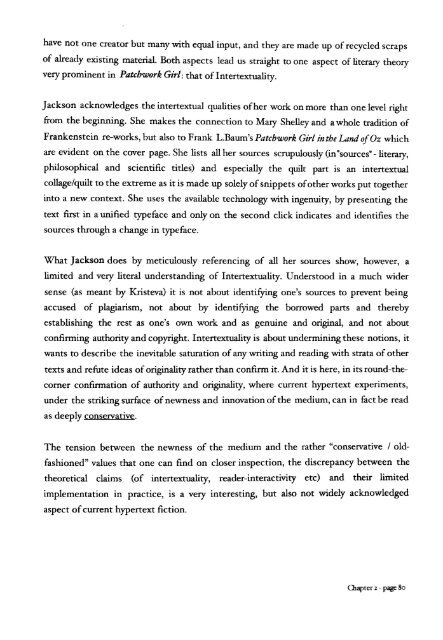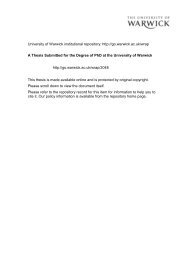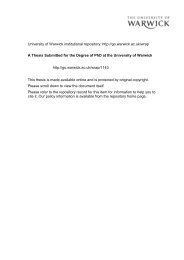From Page to Screen - WRAP: Warwick Research Archive Portal ...
From Page to Screen - WRAP: Warwick Research Archive Portal ...
From Page to Screen - WRAP: Warwick Research Archive Portal ...
Create successful ePaper yourself
Turn your PDF publications into a flip-book with our unique Google optimized e-Paper software.
have not one crea<strong>to</strong>r but many with equal input, and they are made up ofrecycled scraps<br />
of already existing material. Both aspects lead us straight <strong>to</strong> one aspect of literary theory<br />
very prominent in Patchwork Girl: that ofIntertextuality.<br />
Jackson acknowledges the intertextual qualities ofher work on more than one level right<br />
from the beginning. She makes the connection <strong>to</strong> Mary Shelley and a whole tradition of<br />
Frankenstein re-works, but also <strong>to</strong> Frank L.Baum'sPatchwork Girl in the LandofOz which<br />
are evident on the cover page. She lists all her sources scrupulously (in"sources" - literary,<br />
philosophical and scientific titles) and especially the quilt part is an intertextual<br />
collage/quilt <strong>to</strong> the extreme as it is made up solely ofsnippets ofotherworks put <strong>to</strong>gether<br />
in<strong>to</strong> a new context. She uses the available technology with ingenuity, by presenting the<br />
text first in a unified typeface and only on the second click indicates and identifies the<br />
sources through a change in typeface.<br />
What Jackson does by meticulously referencing of all her sources show, however, a<br />
limited and very literal understanding of Intertextuality. Unders<strong>to</strong>od in a much wider<br />
sense (as meant by Kristeva) it is not about identifying one's sources <strong>to</strong> prevent being<br />
accused of plagiarism, not about by identifying the borrowed parts and thereby<br />
establishing the rest as one's own work and as genuine and original, and not about<br />
confirming authority and copyright, Intertextuality is about undermining these notions, it<br />
wants <strong>to</strong> describe the inevitable saturation of any writing and reading with strata ofother<br />
texts and refute ideas oforiginality rather than confirm it. And it is here, in its round-the<br />
corner confirmation of authority and originality, where current hypertext experiments,<br />
under the striking surface ofnewness and innovation ofthe medium, can in fact be read<br />
as deeply conservative.<br />
The tension between the newness of the medium and the rather "conservative / old<br />
fashioned" values that one can find on closer inspection, the discrepancy between the<br />
theoretical claims (of intertextuality, reader-interactivity etc) and their limited<br />
implementation in practice, is a very interesting, but also not widely acknowledged<br />
aspect ofcurrent hypertext fiction.<br />
Chapter 2 - page80





